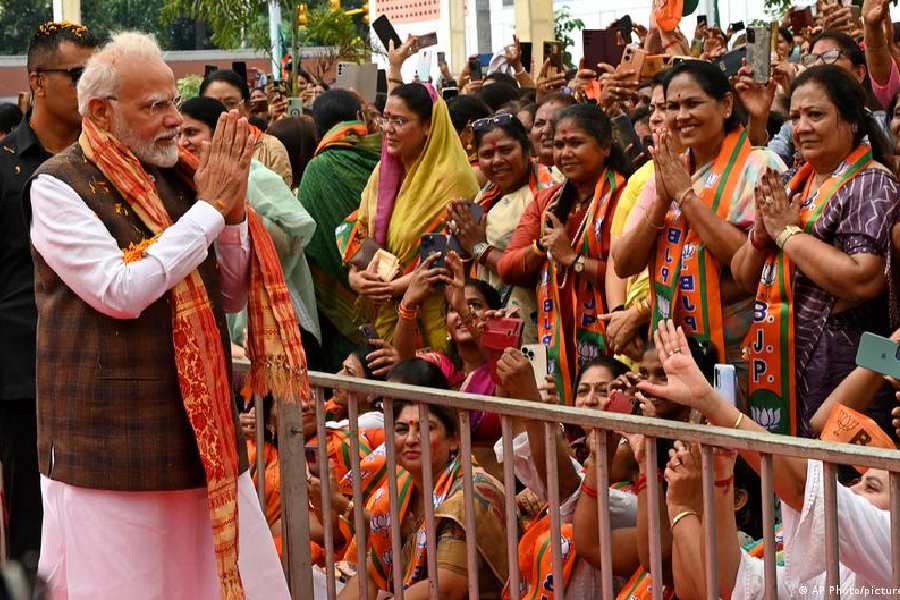India is celebrating a major breakthrough for female politicians — a new law, passed unanimously by parliament, is designed to reserve one-third of seats for women in the lower house of the assembly and the parliaments of India's 28 states.
To Prime Minister Narendra Modi, the law is "a testament to 'Naya Bharat' (New India)" that will be discussed for generations.
"It is our privilege that the chance to script history was given to us by millions of Indians," Modi said addressing the members of his Hindu nationalist Bharatiya Janata Party (BJP).
But the milestone legislation will take a while to become reality. Officials warn that new rules would not be implemented in time for the national elections scheduled in May 2024.
The bill is expected to come into effect only after India's next census, and after delimitation — which is the process of redrawing boundaries of constituencies and would be conducted in 2026. The process will also change the number of seats in parliament and state assemblies.
Many activists and politicians are not convinced by the presented reasons for the delay.
"Why wait for the law to take effect? If political parties are sincerely committed to the idea of female representation, nothing stops them from ensuring that they hand out more tickets to women in general elections," Yamini Aiyar, head of Centre for Policy Research, a Delhi-based think tank, told DW.
Previous attempts to pass the bill have been continuously stalled since it was first introduced first in 1996, with intense resistance from lawmakers. National Congress Party MP Supriya Sule described the latest bill as a "post-dated cheque drawn from a crashing bank."
"It remains to be seen if it can be encashed by its proposed date of 2029. If I am slightly cynical, it is because I have witnessed similar bills being introduced in parliament on different occasions — 1996, 1998, 1999 and 2008 — with much fanfare, but eventually the bills quietly lapsed," said Sule.
Harsimrat Kaur Badal of the Akali Dal party also questioned the inordinate delay in implementing the law.
"Why did you bring this bill when you are not implementing it? The male-dominated parliament betrayed women," said Badal.
Despite an impressive increase in turnout of women voters in recent elections, women who want to enter politics still face deep-rooted structural constraints in India. These barriers can be attributed to societal attitudes, discrimination, and lack of access to resources.
According to the Inter-Parliamentary Union (IPU), an organization which compiles global data on national parliaments, India ranks at 141 out of 187 countries when it comes to women's representation in the top legislative body.
The IPU, which has been tracking and empowering women parliamentarians for decades, said that overall, the environment in political parties was not women-friendly.
"Because of their low proportion in the inner political party structure of India, women fail to gather resources and support for nurturing their political constituencies," said the IPU report.
India saw its first female prime minister, Indira Gandhi, take power in 1966. Women have also been elected chief ministers in India's states, and 11 of them are currently serving as cabinet ministers in PM Modi's government.
But current data confirms that women's representation remains woefully inadequate. The current lower house of India's national parliament, Lok Sabha, has only 15% of female lawmakers — 83 out of 543. In the upper house, only 13% of lawmakers are women.
No Indian state has more than 18% women representation in its assembly. Himachal Pradesh has just one woman legislator and Mizoram has none. Moreover, seven states did not send a single woman to the national parliament in the 2019 elections. In Manipur and Nagaland, not one woman contested the elections in 2019.
There are positive examples too — in the early 90s, village councils or "panchayats" introduced gender quotas. Every five-year election cycle, one-third of villages within each state are selected to have a woman leader of the local council. These amendments are aimed to empower local government and give women a greater say in the governance of their communities.
The latest law is expected to help reduce the gender gap, once it actually goes in effect. But even before then, India's political parties could simply choose to run more female candidates for the women in the 2024 election.
Flavia Agnes, a women's rights lawyer, claims women legislators tend to be more responsive, accountable, and honest. She hopes the new law would improve the quality of and effectiveness of governance.
"Overall, while it is a step forward, we will understand the commitment of each political party towards empowerment of women within the political sphere when they allocate tickets to women candidates in the 2024 general elections," Agnes told DW.











